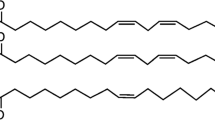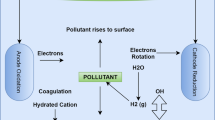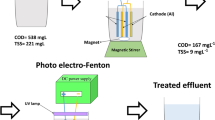Abstract
Electrocoagulation process using Ti electrode was employed for carwash wastewater treatment. Taguchi experimental design method was applied to identify the optimized values of operating parameters for chemical oxygen demand, anionic surfactant and oil–grease removals. The effects of operating parameters on the removal of selected pollutants were investigated. The operating variables were selected as pH: 4–8; current density: 2.5–30 A/m2; stirring speed: 150–350 rpm. 84% chemical oxygen demand, 99.3% anionic surfactant and 82% oil–grease removal efficiencies were achieved under the optimized conditions. The operating cost was calculated as 9.67 $/m3 for these conditions. The analysis of variance results indicated that the current density had the greatest effect on the removals. EC sludge produced at the optimum conditions was analyzed using environmental scanning electron microscopy–energy-dispersive X–ray and Fourier transform infrared spectroscopy analyses. The results indicated that Taguchi design method was suitable to determine the optimum values of operating parameters for EC treatment of carwash effluents. High chemical oxygen demand, anionic surfactant and oil–grease removals showed that electrocoagulation process using Ti electrode can be used for the removal of organic matters from carwash effluents.




Similar content being viewed by others
References
Amani-Ghadim AR, Aber S, Olad A, Ashassi-Sorkhabi H (2013) Optimization of electrocoagulation process for removal of an azo dye using response surface methodology and investigation on the occurrence of destructive side reactions. Chem Eng Process 64:68–78
APHA, AWWA, WEF, (1995) Standard Methods for the examination of water and wastewater. American public health association, Washington DC. ISBN 0-87553-223-3
Ba-abbad MM, Kadhum AAH, Mohamad AB, Takriff MS, Sopian K (2012) Synthesis and catalytic activity of TiO2 nanoparticles for photochemical oxidation of concentrated chlorophenols under direct solar radiation. Int J Electrochem Sci 7:4871–4888
Bayar S, Yıldız YŞ, Yılmaz AE, İrdemez Ş (2011) The effect of stirring speed and current density on removal efficiency of poultry slaughterhouse wastewater by electrocoagulation method. Desalination 280:103–107
Bazrafshan E, Mostafapour FK, Soori MM, Mahvi AH (2012) Application of combined chemical coagulation and electrocoagulation process to carwash wastewater treatment. Fresenius Environ Bull 21(9a):2694–2701
Behin J, Farhadian N, Ahmadi M, Parvizi M (2015) Ozone assisted electrocoagulation in a rectangular internal-loop airlift reactor: application to decolorization of acid dye. J Water Process Eng 8:171–178
Chen X, Deng H (2012) Removal of humic acids from water by hybrid titanium-based electrocoagulation with ultrafiltration membrane processes. Desalination 300:51–57
Chen X, Ren P, Li T, Trembly JP, Liu X (2018) Zinc removal from model wastewater by electrocoagulation: processing, kinetics and mechanism. Chem Eng J 349:358–367
Davila JA, Machuca F, Marrianga N (2011) Treatment of vinasses by electrocoagulation–electroflotation using the Taguchi method. Electrochim Acta 56:7433–7436
Deghles A, Kurt U (2016) Treatment of raw tannery wastewater by electrocoagulation technique: optimization of effective parameters using Taguchi method. Desalin Water Treat 57:14798–14809
Emamjomeh MM, Sivakumar M (2009) Review of pollutants removed by electrocoagulation and electrocoagulation/flotation processes. J Environ Manage 90(5):1663–1679
Fajardo AS, Rodrigues RF, Martins RC, Castro LM, Quinta-Ferreira RM (2015) Phenolic wastewaters treatment by electrocoagulation process using Zn anode. Chem Eng J 275:331–341
Franco D, Lee J, Arbelaez S, Cohen N, Kim J (2017) Removal of phosphate from surface and wastewater via electrocoagulation. Ecol Eng 108:589–596
Garcia-Segura S, Eiband MMSG, de Melo JV, Martínez-Huitle CA (2017) Electrocoagulation and advanced electrocoagulation processes: a general review about the fundamentals, emerging applications and its association with other Technologies. J Electroanal Chem 801:267–299
Gönder ZB, Kaya Y, Vergili I, Barlas H (2010) Optimization of filtration conditions for CIP wastewater treatment by nanofiltration process using Taguchi approach. Sep Purif Technol 70(3):265–273
Gönder ZB, Arayici S, Barlas H (2011) Advanced treatment of pulp and paper mill wastewater by nanofiltration process: effects of operating conditions on membrane fouling. Sep Purif Technol 76:292–302
Gönder ZB, Arayici S, Barlas H (2012) Treatment of pulp and paper mill wastewater using utrafiltration process: optimization of the fouling and rejections. Ind Eng Chem Res 51:6184–6195
Gönder ZB, Balcıoğlu G, Vergili I, Kaya Y (2017) Electrochemical treatment of carwash wastewater using Fe and Al electrode: techno-economic analysis and sludge characterization. J Environ Manag 200:380–390
Hakizimana JN, Gourich B, Vial Ch, Drogui P, Oumani A, Naja J, Hilali L (2016) Assessment of hardness, microorganism and organic matter removal from seawater by electrocoagulation as a pretreatment of desalination by reverse osmosis. Desalination 393:90–101
Hakizimana JN, Gourich B, Chafi M, Stiriba Y, Vial C, Drogui P, Naja J (2017) Electrocoagulation process in water treatment: a review of electrocoagulation modeling approaches. Desalination 404:1–21
Khandegar V, Saroha AK (2013) Electrocoagulation for the treatment of textile industry effluent –A review. J Environ Manage 128:949–963
Kobya M, Ulu F, Gebologlu U, Demirbas E, Oncel MS (2011) Treatment of potable water containing low concentration of arsenic with electrocoagulation: different connection modes and Fe-Al electrodes. Sep Purif Technol 77:283–293
Kumar PR, Chaudhari S, Khilar KC, Mahajan SP (2004) Removal of arsenic from water by electrocoagulation. Chemosphere 55(9):1245–1252
Latha A, Sanjitha GM, Rupitha P, Sangeetha M (2017) Treatment of car wash wastewater by electrocoagulation using moringa olifera as a adsorbent: a review. Int J Emerg Trends Sci Technol 4(2):4981–4987
Liu Y, Hu X, Zhao Y, Wang J, Lu M, Peng F, Bao J (2018) Removal of perfluorooctanoic acid in simulated and natural waters with different electrode materials by electrocoagulation. Chemosphere 201:303–309
Maher EK, O’Malley KN, Heffron J, Huo J, Mayer BK, Wang Y, McNamara PJ (2019) Analysis of operational parameters, reactor kinetics, and floc characterization for the removal of estrogens via electrocoagulation. Chemosphere 220:1141–1149
Martinez-Villafane JF, Montero-Ocampo C (2010) Optimisation of energy consumption in arsenic electro-removal from groundwater by the Taguchi method. Sep Purif Technol 70(3):302–305
Medel A, Ramírez JA, Cárdenas J, Sirés I, Meas Y (2019) Evaluating the electrochemical and photoelectrochemical production of hydroxyl radical during electrocoagulation process. Sep Purif Technol 208:59–67
Mohammadi MJ, Takdastan A, Jorfi S, Neisi A, Farhadi M, Yari AR, Dobaradaran K (2017) Electrocoagulation process to chemical and biological oxygen demand treatment from carwash grey water in Ahvaz megacity. Iran Data Brief 11:634–639
Montgomery DC (2001) Design and analysis of experiments, 5th edn. Wiley, Newyork
Nasrullah M, Zularisam AW, Krishnan S, Mimi S, Singh L, Fen YW (2019) High performance electrocoagulation process in treating palm oil mill effluent using high current intensity application. Chin J Chem Eng 27:208–217
Orha C, Pode R, Manea F, Lazau C, Bandas C (2017) Titanium dioxide-modified activated carbon for advanced drinking water treatment. Process Saf Environ Prot 108:26–33
Panizza M, Cerisola G (2010) Applicability of electrochemical methods to carwash wastewaters for reuse. Part 2: electrocoagulation and anodic oxidation integrated process. J Electroanal Chem 638:236–240
Pardeshi PM, Mungray AA, Mungray AK (2016) Determination of optimum conditions in forward osmosis using a combined Taguchi–neural approach. Chem Eng Res Des 109:215–225
Prajapati AK, Chaudhari PK, Pal D, Chandrakar A, Choudhary R (2016) Electrocoagulation treatment of rice grain based distillery effluent using copper electrode. J Water Process Eng 11:1–7
Qamar Z, Khan S, Khan A, Aamir M, Nawab J, Waqas M (2017) Appraisement, source apportionment and health risk of polycyclic aromatic hydrocarbons (PAHs) in vehicle-wash wastewater. Pakistan Sci Total Environ 605–606:106–113
Ross PJ (1996) Taguchi techniques for quality engineering, 2nd edn. McGraw-Hill, New York
Rubí-juárez H, Barrera-díaz C, Ureña-nuñez F (2017) Adsorption-assisted electrocoagulation of real car wash wastewater with equilibrium and kinetic studies. Pollut Res 36(2):175–184
Sandhwar VK, Prasad B (2017) Terephthalic acid removal from aqueous solution by electrocoagulation and electro-Fenton methods: process optimization through response surface methodology. Process Saf Environ Prot 107:269–280
Shamaei L, Khorshidi B, Perdicakis B, Sadrzadeh M (2018) Treatment of oil sands produced water using combined electrocoagulation and chemical coagulation techniques. Sci Total Environ 645:560–572
Song P, Yang Z, Zeng G, Yang X, Xu H, Wang L, Xu R, Xiong W, Ahmad K (2017) Electrocoagulation treatment of arsenic in wastewaters: a comprehensive review. Chem Eng J 317:707–725
Subtil EL, Rodrigues R, Hespanhol I, Mierzwa JC (2017) Water reuse potential at heavy-duty vehicles washing facilities—The mass balance approach for conservative contaminants. J Clean Prod 166:1226–1234
Taheri M, Moghaddam MRA, Arami M (2015) Improvement of the/Taguchi/Design optimization using artificial intelligence in three acid azo dyes removal by electrocoagulation. Environ Prog Sustain Energy 34(6):1568–1575
Tavangar T, Jalali K, Shahmirzadi MAA, Karimi M (2019) Toward real textile wastewater treatment: membrane fouling control and effective fractionation of dyes/inorganic salts using a hybrid electrocoagulation-Nanofiltration process. Sep Purif Technol 216:115–125
Wajima T, Umeeta Y, Narita S, Sugawara K (2009) Adsorption behavior of fluoride ions using a titanium hydroxide-derived adsorbent. Desalination 249:323–330
Yang B, Han Y, Yu G, Zhou Q, Deng S, Wu J, Zhang P (2016) Efficient removal of perfluoroalkyl acids (PFAAs) from aqueous solution by electrocoagulation using iron electrode. Chem Eng J 303:384–390
Zhang G, Fan F, Li X, Qi J, Chen Y (2018) Superior adsorption of thallium(I) on titanium peroxide: performance and mechanism. Chem Eng J 331:471–479
Zhao YX, Gao BY, Shon HK, Kim J-H, Yue QY (2011) Effect of shear force, solution pH and breakage period on characteristics of flocs formed by Titanium tetrachloride (TiCl4) and Polyaluminum chloride (PACl) with surface water treatment. J Hazard Mater 187:495–501
Zodi S, Potier O, Lapicque F, Leclerc J (2010) Treatment of the industrial wastewaters by electrocoagulation: optimization of coupled electrochemical and sedimentation processes. Desalination 261:186–190
Acknowledgements
This study was funded by Scientific Research Projects Coordination Unit of Istanbul University-Cerrahpasa (Project Numbers: 53606 and 25085).
Author information
Authors and Affiliations
Corresponding author
Additional information
Editorial responsibility: Binbin Huang.
Rights and permissions
About this article
Cite this article
Gönder, Z.B., Balcıoğlu, G., Kaya, Y. et al. Treatment of carwash wastewater by electrocoagulation using Ti electrode: optimization of the operating parameters. Int. J. Environ. Sci. Technol. 16, 8041–8052 (2019). https://doi.org/10.1007/s13762-019-02413-4
Received:
Revised:
Accepted:
Published:
Issue Date:
DOI: https://doi.org/10.1007/s13762-019-02413-4




